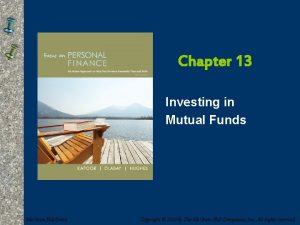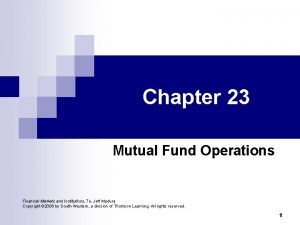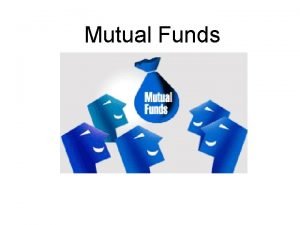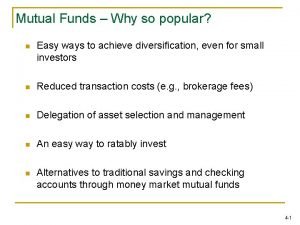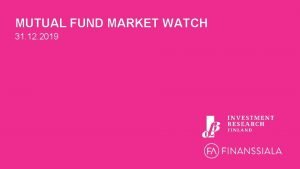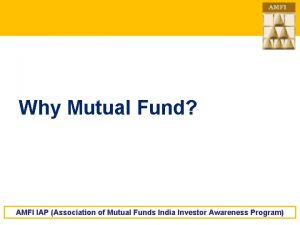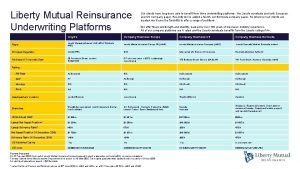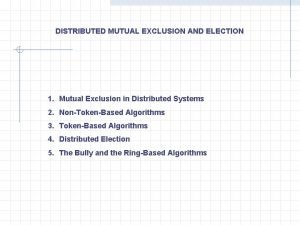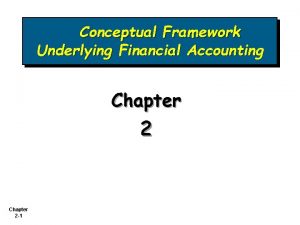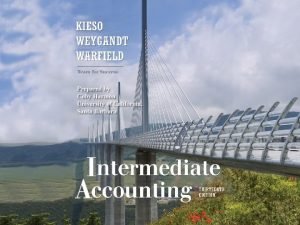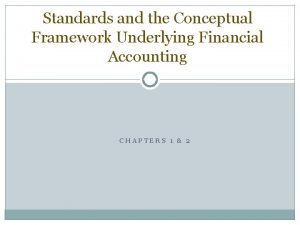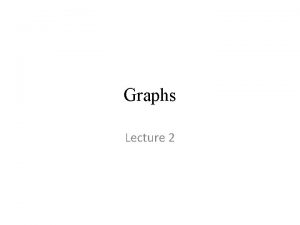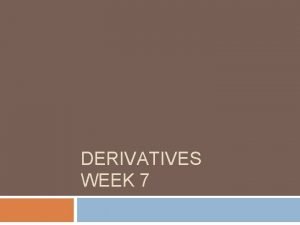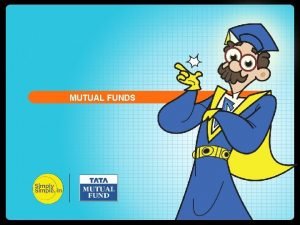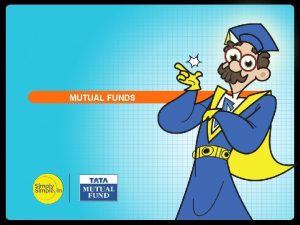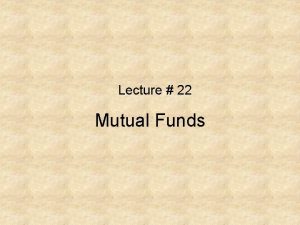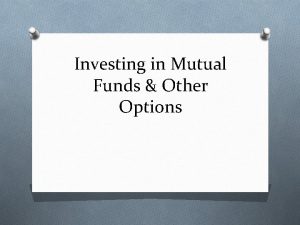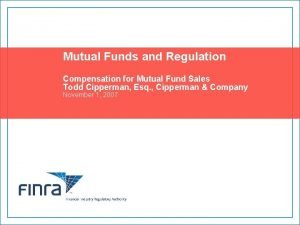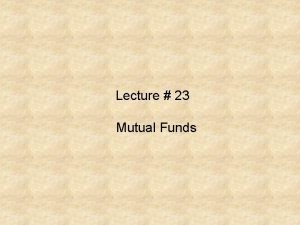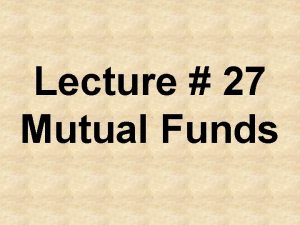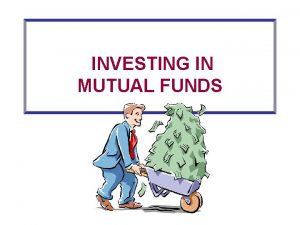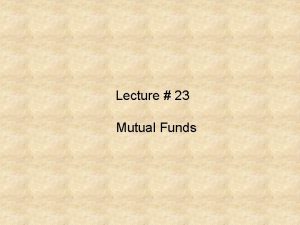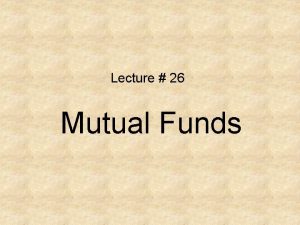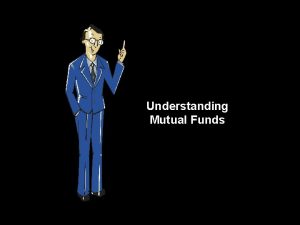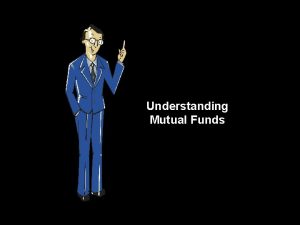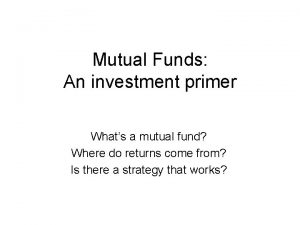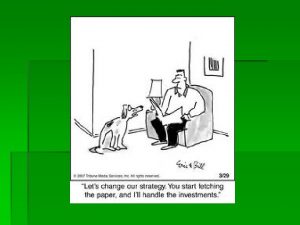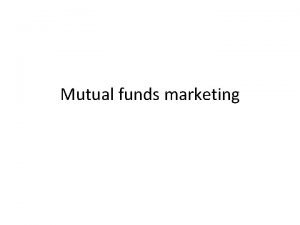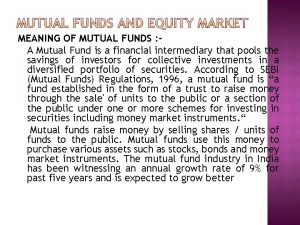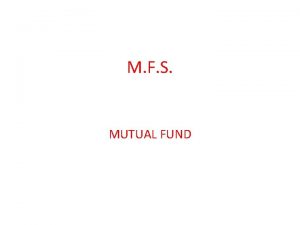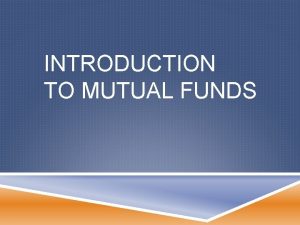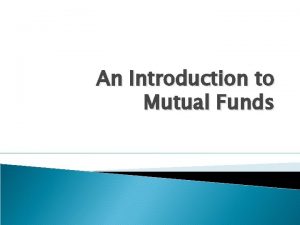Comparing Mutual Funds Researching Funds The underlying principle
















































- Slides: 48

Comparing Mutual Funds

Researching Funds The underlying principle of U. S. securities regulation is disclosure. The primary disclosure document issued by a fund is the summary prospectus. A fund also prepares a prospectus and a statement of additional information. Funds report to shareholders at least twice a year in the annual and semi-annual reports. Fund advertising is strictly regulated.

Disclosure Under U. S. law, anyone who wants to sell a security to the public must: Register the offering of the security with the SEC. Provide buyers with a document called a prospectus which discloses material information about the investment. Report periodically to buyers about their investment after the security has been issued.

Disclosure and Mutual Funds Mutual funds are securities that are offered to the public every day. Therefore, they must have a prospectus available every day. They issue a series of documents with varying levels of detail to meet the needs of different investors. The summary prospectus is a short document with highlights only. The prospectus contains all material information that the SEC believes is needed for an investor to make an informed purchase decision. The statement of additional information provides more detail.

Finding Fund Documents Fund documents are available through: The management company’s web site Most online financial sites (Morningstar, Yahoo Finance, etc…) EDGAR system available on the SEC’s web site Financial provider sites

Summary Prospectus: Overview The summary prospectus: Was first used in May 2009. Is expected to become the primary disclosure document. Must be written in plain English. Can only be for one fund. Has eight sections, which must appear in a specified order.

Summary Prospectus Sections (1)

Summary Prospectus Sections (2)

Summary Prospectus Sections (3)

Limitations on Mutual Fund Names

Some Investment Objectives

Summary Prospectus Sections (4)

Summary Prospectus Sections (5)

Summary Prospectus-Example Fidelity Stock Selector Mid Cap (FSSMX)

Prospectus Additional information in the prospectus includes: Detail on investment strategies and risks. Information on the time the fund calculates its NAV. Information on restrictions with regard to purchases and sales of fund shares, especially for short-term trading. Detail on sales charges. A financial highlights table.

Statement of Additional Information Additional information in the statement of additional information includes details on: The board of directors. The portfolio manager(s). Contracts with service providers. The fund’s history.

Shareholder Reports Funds issue reports to shareholders at least twice annually. The annual and semiannual shareholder reports usually include: Portfolio commentary, from the investment manager. A president’s letter, from the chief executive of the management company. Board discussion of contract renewal, explaining why the board signed a contract with the management company. Holdings list. Financial statements, including the statement of operations, statements of assets and liabilities, and statement of changes in net assets.

Fund Advertising Fund advertising is strictly regulated. Restrictions apply to anything sent out to promote a fund, including a fund sponsor’s entire Internet presence. Fund distributors must file all advertising material with FINRA within 10 business days of first use. FINRA reviews submissions to determine if they are fair and balanced and provide a sound basis for evaluating the fund. Ads may not be misleading. FINRA can suggest changes, require revisions or issue a “Do Not Use” letter. Ads must present performance information in a standard format.

Calculating Total Return

Example Initial Investment NAV=$10. 00 Income distribution per share=$0. 20 Capital Gains distribution per share=$0. 30 Current NAV=$12. 00 Total Return=? What is total distribution per share? (remember, this distribution is reinvested in fund again) What is total return (adjusted for distribution)?

Comparing Mutual Funds There are four main types of mutual funds: money market funds, bond funds, stock funds and hybrid funds. Each group has subcategories. Stock funds can be categorized by style box or investment objective. There is considerable discussion of the merits of passive investing versus active investing. Investors evaluate fund performance by comparing return and risk. Most investors compare mutual funds using 1 of 3 methods: peer group comparison, index comparison and risk-adjusted performance calculation. A few investors focus on yield or expenses.

Understanding Categories There are 4 main categories of mutual funds: Money market funds Bond funds Stock funds Hybrid funds The categorization is based on the main type of securities a fund holds.

Money Market Funds Money market funds: Are the fund type that is most like bank savings accounts, though they are not insured by the federal government. Pay relatively low rates of interest (i. e. , have a low yield). Afford a high degree of safety, because they generally do not decline in value. Ordinarily have a stable NAV of $1 per share.

Money Market Funds

After-Tax Yield To compute the after-tax yield on a tax-exempt fund: • Assuming: Pre-tax yield = 4. 00% Federal tax bracket = 35. 00% State tax bracket = 9. 55% State taxes paid are deductible for federal income tax purposes. Total tax rate = 35. 00% + 9. 55% x (1 – 35. 00%) = 41. 21% After-tax yield = 4. 00% x (1 – 41. 21%) = 2. 35%

Bond Funds Bond funds: Normally pay a higher rate of interest than money market funds. Do not have the same level of security as money market funds; they can decline in value. Have a NAV that can vary from day to day. Invest in bonds. These are, in essence, loans to a government or a corporation that promises to repay the money with interest.

Bond Funds (1)

Bond Funds (2)

Bond Fund Indices Corporate Bonds Barclays Capital Intermediate U. S. Corporate Index Barclays Capital Long U. S. Corporate Index Barclays Capital U. S. Utility Bond Index Emerging Markets Bonds Barclays Capital EM Local Currency Government Capped Index J. P. Morgan Government Bond Index Emerging Markets Global Core Index Government Bonds Barclays Capital Long U. S. Treasury Index Barclays Capital U. S. 1 -3 Year Government Bond Index Barclays Capital U. S. Intermediate Treasury Index High Yield Bonds Barclays Capital High Yield Very Liquid Index Bof. A Merrill Lynch 0 -5 Year US High Yield Constrained Index Total Bond Market Barclays Capital U. S. 1 -5 Year Government/Credit Bond Index Barclays Capital U. S. 5 -10 Year Government/Credit Bond Index Barclays Capital U. S. Aggregate Bond Index

Stock Funds Stock funds: Generally don’t provide much income. Are owned by investors who believe the funds’ NAVs will appreciate in value. Invest in stocks. These are, in essence, ownership positions in corporations. – Small, Mid, Large, Mega – Value, Growth, Core

Stock Funds

Style Box Style boxes classify funds in a grid along two dimensions. They were popularized by Morningstar. These dimensions are: Investment style , which summarizes the types of stocks the fund invests in. Value = reasonably priced in relation to PE Core or blend = gravitates around index Growth = fast-growing companies Market capitalization or market cap, which equals the stock price times the number of shares outstanding. Large Cap: $10 billion plus Mid Cap: $2 billion to $10 billion Small Cap: Less than $2 billion

Style Box Pros and Cons Arguments for the style box classification: It allows investors to compare funds using similar approaches. It helps investors to diversify among funds with different approaches. Arguments against the style box: Funds can move among style boxes as the market changes; this is not necessarily style drift. Funds that remain firmly within one style box may miss opportunities to make money.

Style Box

Why does Fund Style matter? T. Rowe Instl Large Cap (TRLGX) versus T. Rowe Instl Small Cap (TRSSX)

Why does Fund Style matter? T. Rowe Instl Large Cap (TRLGX) versus T. Rowe Instl Small Cap (TRSSX)

Why does Fund Style matter? T. Rowe Instl Large Cap (TRLGX) versus T. Rowe Instl Small Cap (TRSSX)

Hybrid Funds Hybrid funds: Invest in a combination of bonds and stocks. Balanced Funds Asset Allocation Funds Target Retirement Funds Significant debate about index and peer comparison

Hybrid Funds

Hybrid Funds

Evaluating Fund Performance Most investors evaluate fund performance by looking at return and risk. Return is always total return. Risk is the variability in fund returns, usually measured by the standard deviation in returns. Most investors use one of three methods for comparing funds: Peer group comparison. Index comparison. Risk-adjusted performance calculation.

Peer Group Comparison A peer group comparison evaluates fund performance relative to other funds in the same subcategory. These funds form a peer group or competitive universe. A fund is measured against a peer group in two ways: The fund’s return is compared to the average return. The fund’s return is ranked within the peer group. Lipper and Morningstar are the primary providers of peer group information for all fund types except money market funds. Lipper and i. Money. Net are the primary providers for money market funds.

Index Comparison An index comparison evaluates fund performance relative to a market index or benchmark. A market index is a hypothetical portfolio of securities chosen to represent the market or a segment of it. Indexes are maintained by independent firms. Barclays Capital, Dow Jones, J. P. Morgan, MSCI, Russell Investments and Standard & Poor’s are well-known index providers. A fund’s return is compared to the index return. If the fund return is higher, the fund outperforms. If the fund return is lower, the fund underperforms.

Example Artisan Value Investor (ARTLX)

Risk-Adjusted Performance Comparison A risk-adjusted performance comparison evaluates fund performance relative to the risk that it is has taken. Peer group and index comparisons provide some adjustment for risk. The best-known risk-adjusted comparison is the Morningstar rating. Fund performance is divided by Morningstar’s proprietary measure of risk. The results are ranked within peer groups.

Active vs. Passive

The Case for Index Funds The market is so efficient that it is impossible for active managers to outperform. And there’s no evidence that even the best actively-managed funds persistently outperform. Index funds have an expense advantage. They are easier to manager and, therefore, can charge lower fees. Lower fees lead to better performance. Index funds are more tax-efficient. They trade securities less frequently, so they generate fewer capital gains.

The Case for Active Management There is a group of highly skilled, experienced managers who consistently outperform. Active managers tend to outperform in certain market environments. Index funds are building up large accumulated capital gains. The work of active managers is what makes the markets efficient. Index fund investors are free riders on the work of active managers. Markets are not as efficient as index fund proponents suggest.
 Chapter 13 investing in mutual funds
Chapter 13 investing in mutual funds Mutual funds disclaimer
Mutual funds disclaimer Mutual funds operations
Mutual funds operations Mutual funds disclaimer
Mutual funds disclaimer Aim mutual funds
Aim mutual funds Mutual funds examples
Mutual funds examples Meritas mutual funds
Meritas mutual funds Mutual funds market watch
Mutual funds market watch Iap mutual funds
Iap mutual funds Reinsurance mutual funds
Reinsurance mutual funds Researching the corruption
Researching the corruption Chapter 3 researching careers
Chapter 3 researching careers Researching wan technologies
Researching wan technologies Researching
Researching Ricart agrawala second algorithm
Ricart agrawala second algorithm Conceptual framework underlying financial accounting
Conceptual framework underlying financial accounting Underlying network
Underlying network Underlying technology
Underlying technology The underlying theme of the conceptual framework is
The underlying theme of the conceptual framework is Characteristics of light
Characteristics of light Basic mechanisms underlying seizures and epilepsy
Basic mechanisms underlying seizures and epilepsy Underlying cause and immediate cause
Underlying cause and immediate cause Underlying magic pitch deck
Underlying magic pitch deck Visual organization and interpretation
Visual organization and interpretation Underlying causes of ww1
Underlying causes of ww1 Threshold theory cummins
Threshold theory cummins Assumptions of conceptual framework
Assumptions of conceptual framework Underlying technology
Underlying technology Pitch deck template by guy kawasaki
Pitch deck template by guy kawasaki Underlying principles
Underlying principles 4 causes of world war 1
4 causes of world war 1 Underlying theory in research
Underlying theory in research Underlying magic
Underlying magic Underlying assumptions of ai
Underlying assumptions of ai Underlying undirected graph
Underlying undirected graph What are the underlying assets in derivatives
What are the underlying assets in derivatives Underlying magic slide
Underlying magic slide Ww1 causes
Ww1 causes Militarism def
Militarism def Từ ngữ thể hiện lòng nhân hậu
Từ ngữ thể hiện lòng nhân hậu Diễn thế sinh thái là
Diễn thế sinh thái là Vẽ hình chiếu vuông góc của vật thể sau
Vẽ hình chiếu vuông góc của vật thể sau Thế nào là giọng cùng tên?
Thế nào là giọng cùng tên? Làm thế nào để 102-1=99
Làm thế nào để 102-1=99 Hát lên người ơi
Hát lên người ơi Tỉ lệ cơ thể trẻ em
Tỉ lệ cơ thể trẻ em Lời thề hippocrates
Lời thề hippocrates Hổ đẻ mỗi lứa mấy con
Hổ đẻ mỗi lứa mấy con đại từ thay thế
đại từ thay thế
